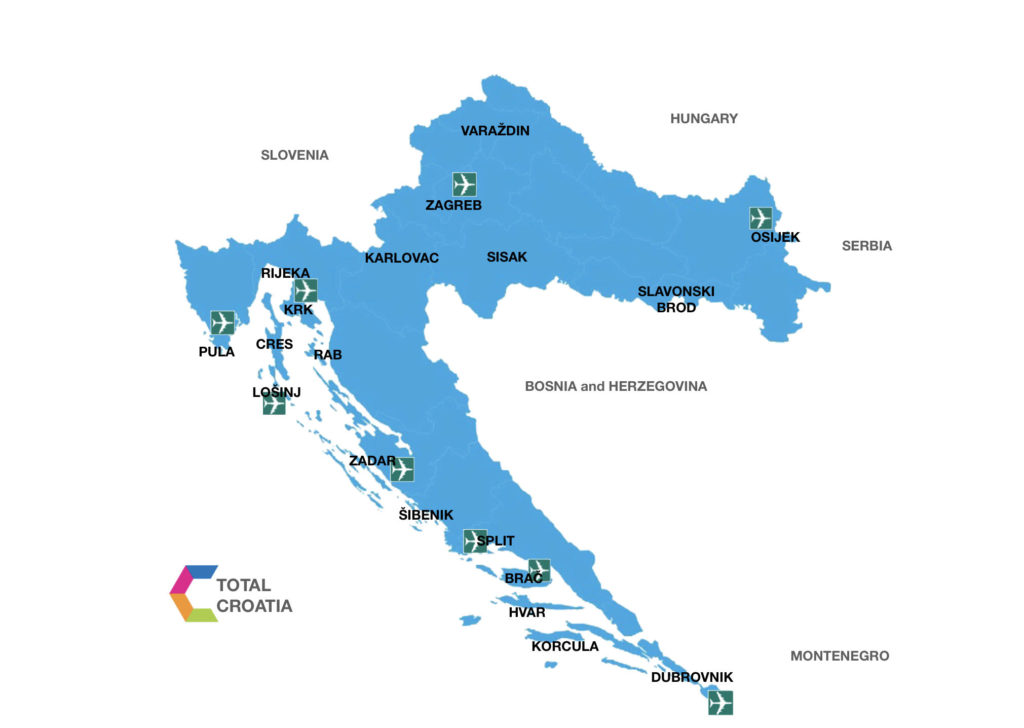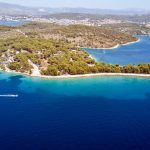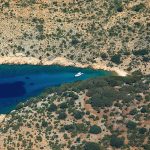The cities in Croatia are diverse, dispersed, historic and stunning. Each has its own unique charms, attractions and heritage.
- The main cities in Croatia: an introduction
- A cities in Croatia map
- The present capital city of Croatia: meet Zagreb
- A former capital of Croatia: meet baroque Varazdin
- Where is the most beautiful city in Croatia? Could it be Split?
- Alternative and anti-establishment: meet Red Rijeka
- The gateway to Istria: historic Pula
- Pearl of the Adriatic, Kings Landing, Ragusa Republic: majestic Dubrovnik
- A previous capital of Dalmatia: Zara, now Zadar
- Sibenik, the fortress city with 2 UNESCO World Heritage Sites
- Slavonski Brod, fortress guardian of the northern borders
- Karlovac, a beer capital on four rivers
- Ancient capital cities of Croatia: Nin and Knin
- Main towns on Croatian islands: Krk, Korcula, Brac, Hvar, Rab, Pag & Losinj
The main cities in Croatia: an introduction
Croatia has a population of around 4 million people, which is spread all over the country. The biggest city is, of course, the capital Zagreb. Much of the rest of the population lives in cities and towns along the spectacular Adriatic coast.
When is a town a city, or a city a town? In Croatia, there is no discernible difference, as both are the same word in Croatian – Grad.
So where exactly are these famous tourist cities in Croatia? And what is there to see and do?
A cities in Croatia map
The present capital city of Croatia: meet Zagreb
Ten years ago, a German magazine named Zagreb as the most boring capital city in Europe. And I would have agreed with them. What a difference a decade makes! It was named as Lonely Planet’s Best Destination in Europe in 2017. And with its award-winning Advent in Zagreb lighting up the colder winter months, Zagreb is arguably the most transformed destination during my 18 years in Croatia.
Where once the food was one-dimensional, there has been an explosion of international food options serving both locals and a growing number of expats and digital nomads. The startup scene is vibrant, and there is a great energy in the capital these days. This despite the devastation of the March 2020 earthquake.
Zagreb is a very green city, with numerous parks. The launch of the Around Zagreb initiative in 2020 also showed how many fantastic options there are to explore in the surrounding areas. Population of the city in the 2011 census – 688,163. Learn more about the current Croatian capital in the TC Zagreb in a Page guide. Flying to the capital? All you need to know about Zagreb Airport.
A former capital of Croatia: meet baroque Varazdin
Zagreb may be today’s capital, but it was not always the case. Indeed, had it not been for a fire started by a man visiting the dentist in the former capital, Varazdin, back in 1776, it may never have been so important today.
Although Varazdin was the capital for only 20 years, it retains a majestic presence. The Baroque old town is compact and exquisite, one of the most beautiful in all Croatia. And if you could choose a time to visit, then make it during Spancirfest. The biggest street festival in the country normally takes place in late August. Then follows another cultural festival for which Varazdin is famous – Varazdin Baroque Evenings.
After 13 years of living on Hvar, I moved to Varazdin in late 2016. And I have to confess that I love it. Is it the very best place to live in Croatia? Perhaps. Here is the case for Varazdin. Learn more about this continental treasure in Varazdin in a Page. Population 38,839.
Where is the most beautiful city in Croatia? Could it be Split?
Another city which has undergone massive change in recent years is the Dalmatian capital, Split. Known for years as the Gateway to the Dalmatian Islands, Split has emerged as one of the top destinations on the Adriatic in recent years. A vibrant expat community and increasing international dining options have helped to develop the city’s appeal. But the Dalmatian food and wine still dominate. And rightly so, for they are delicious.
If the UNESCO World Heritage Site of Diocletian’s Palace good enough for a retiring Roman Emperor, and the timeless laganini lifestyle of the stylish Riva showcasing what some believe are the most beautiful women in the world, it is perhaps little wonder that some locals consider it not only the most beautiful city in Croatia, but also the world.
My colleague Dani certainly thinks so. Here is her case for Split as the best place to live in Croatia. Learn more in Split in a Page. Population 167,121. Flying to the Dalmatian capital? All you need to know about Split Airport.
Alternative and anti-establishment: meet Red Rijeka
I find Rijeka fascinating. If you were born in 1900 and did not leave your house until 1992, you would have lived in 12 different countries or stats. Rijeka, known as Fiume in Italian, has been a real melting pot over the centuries, aided by its status as the main port in Croatia.
It also evokes strong emotions about Croatian friends, who either love or hate it, depending on their politics. For the city is not known as Red Rijeka for nothing. It also has a vibrant alternative scene. Corona robbed the city of its moment in the limelight as the European Capital of Culture 2020. I attended the opening night, which remains one of the best nights of my time in Croatia. Get to know the city better with Rijeka in a Page. Population 128,384. Flying to Rijeka? All you need to know about Rijeka Airport.
Do some people thing Rijeka is the best place to live? Absolutely.
The gateway to Istria: historic Pula
Pula is the main population centre on the gorgeous Istrian peninsula. Pula Arena, the sixth largest Roman amphitheatre in the world, and one of Croatia’s most unusual event locations, dominates the centre. The Arena has hosted an ice hockey match, football match, rock festivals and Roman gladiator fights.
Across the bay are the cranes of the Uljanik shipyard, whose dormant status has been put to creative use with the Lighting Giants project. Pula is known as the City of Tolerance, and its strong military history perhaps partly explains why it is the only big city on the coast whose centre is not focused on the sea. Learn more in Pula in a Page. Population 57,460. Flying in? Pula Airport is 15 minutes from the centre.
Pearl of the Adriatic, Kings Landing, Ragusa Republic: majestic Dubrovnik
It is one of the most iconic cities in Europe, with a history and heritage quite like no other. Abolishing slavery back in 1416, the Republic of Ragusa recognised the United States before almost everyone else. Its trading fleets dominated the high seas, and its diplomats preserved its independent status between Venice and the Ottoman Empire.
Modern Dubrovnik tourism has been dominated by cruise tourism and its Game of Thrones alter ego of Kings Landing. Any complaints of overtourism disappeared with the pandemic. And now the city is reinventing itself with the world’s first Digital Nomad-in-Residence programme.
The best time to visit? The first week of February for the Feast of St Blaise, the beloved patron saint of Dubrovnik. It is magical – this was my visit a few years ago. Learn more in Dubrovnik in a Page. Your nearest flight connection is Dubrovnik Airport. Population 28,434.
A previous capital of Dalmatia: Zara, now Zadar
Zadar is one of Croatia’s most fascinating and most historic cities. A former capital of Dalmatia, it is also known as Zara in Italian, and the city has a strong Italian connection. Its tourism fortunes improved considerably in 2007, when Ryanair opened its 54th European base at Zadar Airport.
The birthplace of Luka Modric, who honed his skills on the streets of the city as a child, Alfred Hitchcock gave the tourism board a boost when he declared Zadar to have ‘the most beautiful sunset in the world.’ The Greetings to the Sun attraction just next to the unique and very natural sea organ are two of the city’s top attractions. Learn more in Zadar in a Page. Population 71,471.
Sibenik, the fortress city with 2 UNESCO World Heritage Site
If there is one underrated city on the Croatian coast, it has to be Sibenik. Home to two UNESCO World Heritage Sites, a Michelin Star restaurant, and some incredible fortresses, the oldest Croatian city on the coast oozes charm and authenticity. If you are looking to find a top destination away from the crowds, this is it.
Nestled between Zadar and Split, it is also within easy reach of islands, national parks and Split Airport. Find out more in Sibenik in a Page.
Slavonski Brod, fortress guardian of the Bosnian border
Known simply as ‘Brod’, the Croatian word for ship, the name of the country’s seventh-largest city pays reference perhaps to its strategic position on the River Sava. The city is dominated by Brod Fortress, one of the most impressive in Croatia, and well worth a visit. Population 53,581.
Karlovac, a beer capital on four rivers
You will not be in Croatia very long before you encounter Karlovacko beer, the most famous export from Karlovac. The city, whose claims to fame include being part of Michael Jackson’s Earth Song, boasts no less than four rivers. And there is plenty of greenery to enjoy. About 40 minutes south of Zagreb, Karlovac is a very affordable and commutable option for the capital. Learn more about the city in 25 things to know about Karlovac. Population 46,833.
Ancient capital cities of Croatia: Nin and Knin
There are also two other former capital cities in Croatia. Nin is the oldest royal town in Croatia. It was also the first capital of the Croatian kings back in the 9th century. It is also famous for having the smallest cathedral in the world.
The other former capital is Knin, more famous these days due to Operation Storm and the liberation of Croatia in 1995. Back in the 11th century, however, Knin was at the height of its influence. Known as the City of Kings, Knin became the Croatian capital and was the Seat of Kings.
The imperious fortress, which overlooks the surrounding area, is of major strategic importance. It is also the second-largest fortress in Europe.
Main populations on Croatian islands: Krk, Korcula, Brac, Hvar, Rab, Pag & Losinj
There are no big cities on the Croatian islands, but there are several islands with significant populations. Among the most populous are Krk (19,383), Korcula (15,522), Brac (13,956), Hvar (11,077), Rab (9,328), Pag (9,059), and Losinj (7,587).











